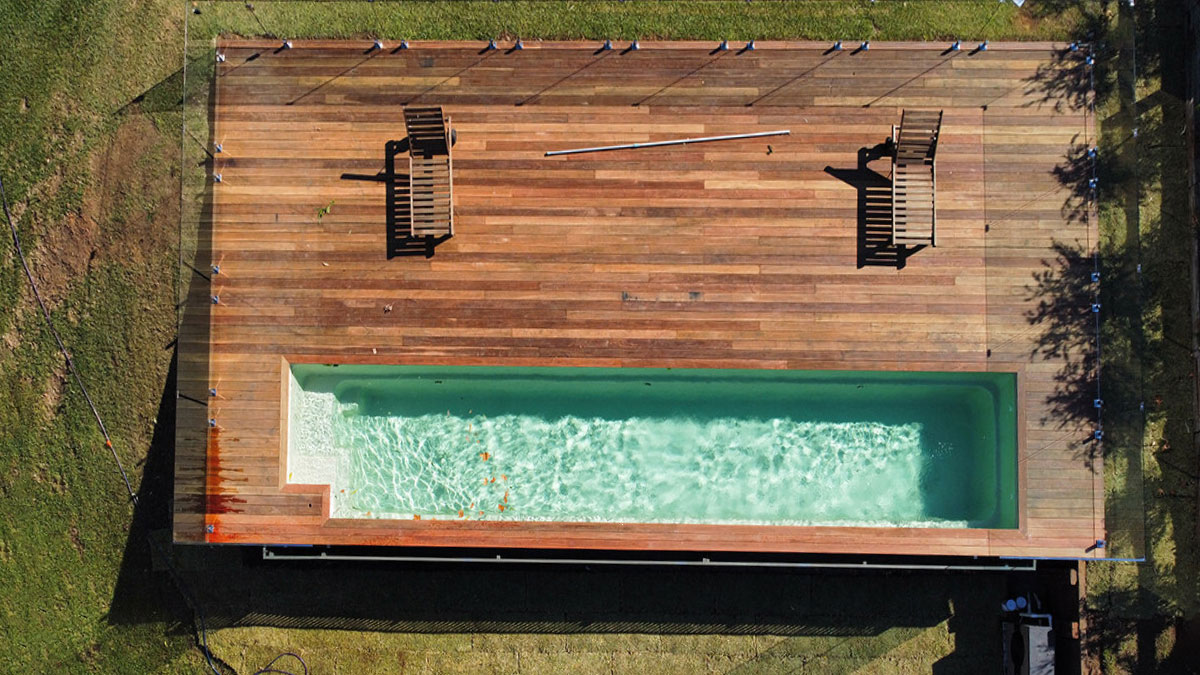
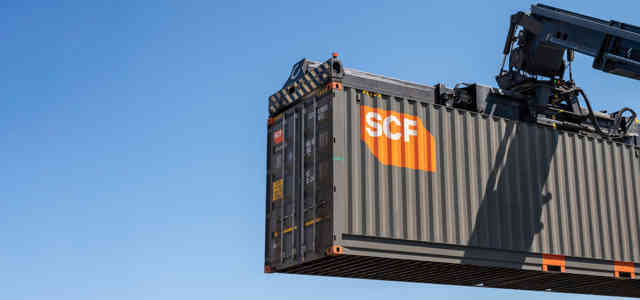
News & Articles
Designs, Inspiration and the How To on Shipping Container Pools
Australia is renowned for its outdoor lifestyle, scorching hot summers and abundance of swimming pools. According to research, almost 2.7 million Australians live in a house with a swimming pool. But in a country of shrinking house blocks, the traditional backyard pool is losing out to lower cost, prefabricated and smaller options, like shipping container pools.
Contents
- What is a shipping container pool?
- The popularity of container pools in Australia
- How to convert a shipping container into a container pool
- How much does a container pool cost to build?
- Above ground vs below ground container pools
- Do you need planning permission to install a pool?
- List of the best shipping container pools for inspiration
- Top 5 benefits of an integrated shipping container pool
- Are there any disadvantages to container pools?
- How to choose the right size for your pool layout
- How deep are container pools?
- How long does it take to install a shipping container pool?
- Is a shipping container pool right for your layout?
- Still keen to install a container pool?
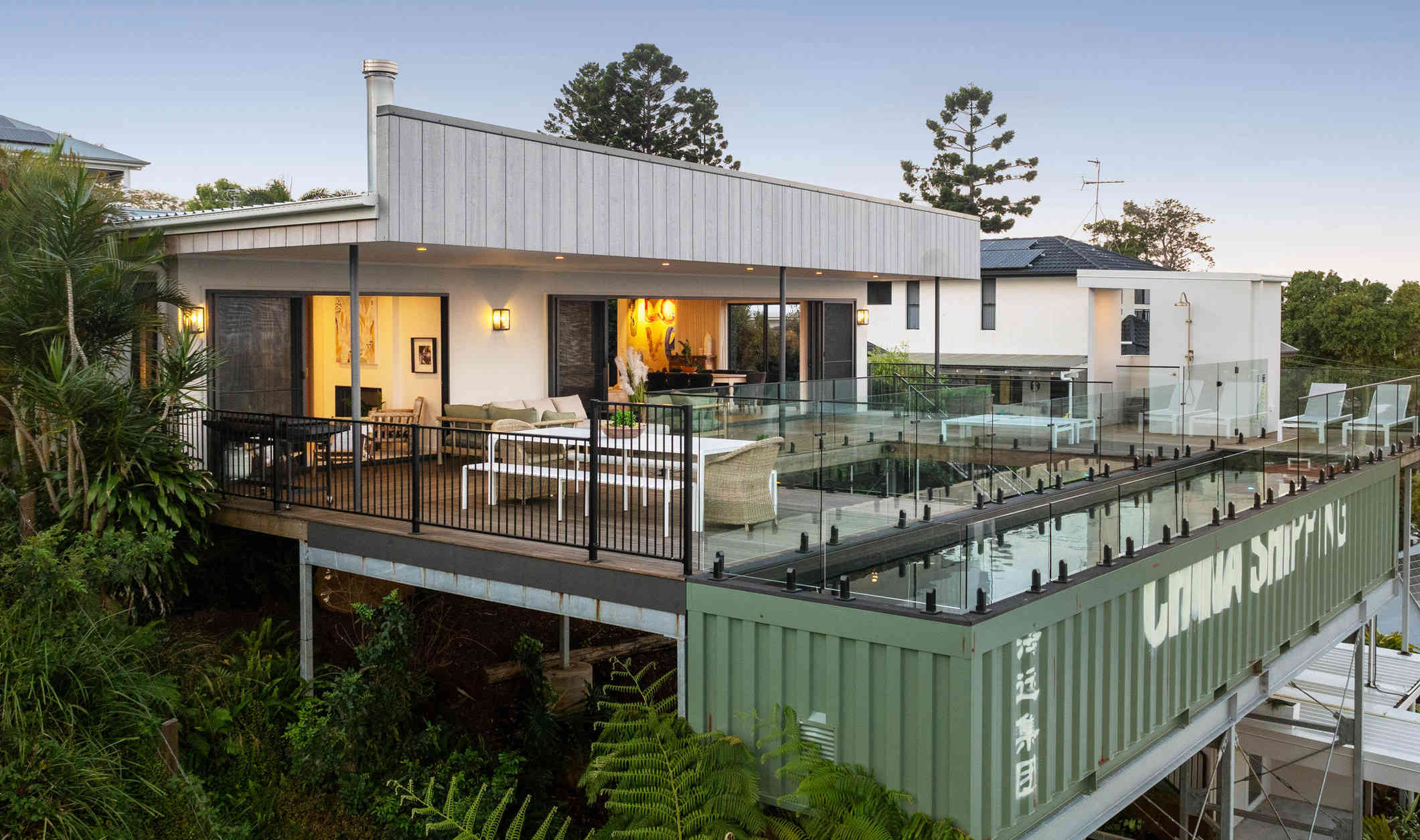
So why are container pools so popular? Cost is often at the top of the list, along with convenience. A container pool can be delivered to site, then lowered into place onto footings. Some favour the industrial look of corrugation and steel, so they can sit above ground, further reducing the installation cost.
However, are container swimming pools as cheap, easy and convenient as they’re made out to be? Or are they similar to shipping container homes - often more expensive, complex and challenging than first thought?
What is a shipping container pool?
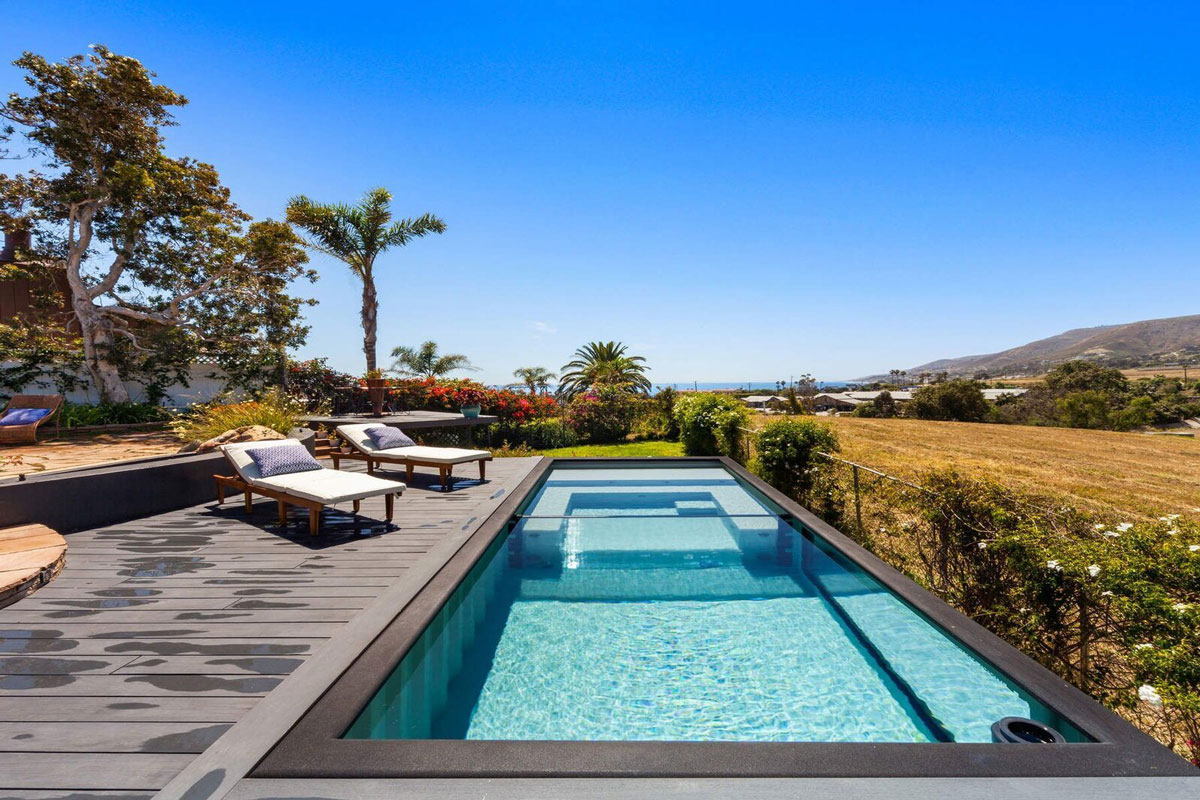
A container pool in a backyard, beneath a palm tree. Source: dwell.com
A shipping container pool is a fibreglass pool shell dropped into a shipping container, the roof of which has been removed.
These prefabricated units come with pumps, a filtration system, and all the piping infrastructure required. In effect, it is a ready made pool that can be used once it is lowered onto pre-prepared footings, connected to power and filled with water.
Both 20ft and 40ft containers can be used, depending on the space available in the yard.
They often sit above the ground, where the corrugation of the shipping container is visible. Some owners will plant around the container to hide the steel exterior. A hole can also be dug in the ground to insert a container pool.
Many Australians grew up with large kidney shaped pools that were dug out in yards, concreted or tiled, surrounded by slate pavers, palms and ferns.
As styles evolved, the materials used, methods deployed and shapes of pools have changed. So much so that a kidney pool surrounded by slate and some ferns are more of a rarity.
Cheaper options, like fibreglass pools that can be lowered into a hole, are more common. They come in a range of shapes and sizes, from the traditional rounded ends, to more modern square plunge pool styles and everything in between. They are transported by truck from factory to location with ease.
However, a key challenge with pools is their size. Over the past 15 years block sizes for new houses has decreased by 22% whilst the size of houses has remained the same, according to the ABS.
Smaller yards have put pressure on traditional pool sizes. These days homeowners often look to install a small pool so they still have some yard or entertaining space. Especially in locations with cold winters, like Victoria and South Australia, where a pool might go unused for 6 months or more.
This is where container pools come into their own. With limited access on site to excavate holes for pools, a prefabricated container pool can be delivered to site and lowered onto footings. The easy installation paired with the lower cost represents the perfect pool.

How to convert a shipping container into a container pool?
Similar to shipping container homes, people often think it is easy to acquire a shipping container and quickly convert it into a swimming pool.

Unfortunately it is not that simple.
The pool shell needs to fit snugly inside a container. These shells are manufactured by specialist container pool providers who have developed a range of molds to fit various sized containers.
In addition to the shell, the piping, pumps and infrastructure are also built into the unit. Again, this is designed to fit neatly within the container footprint.
Unless you have a trade or significant experience and skills with swimming pool installations and servicing, it is not possible to build a container pool yourself
Finally, stairs and additional safety features, like a pool fence which is required for all pools in Australia, is installed as part of the container pool. Similar to the shell, these are purpose built parts that are manufactured and installed by a company that specialises in container pools.
Unless you have a trade or significant experience and skills with swimming pool installations and servicing, it is not possible to build a container pool yourself. Nor is it possible for a shipping container supplier, like SCF, to build a container pool for you in a depot.
You would need to engage a dedicated container pool company to build a container pool almost from scratch.
How much does a container pool cost to build?
Shipping container pool cost is one of the most critical perceived benefits when compared to other pool options. In the mind of the buyer, they are much cheaper than other options.
Gone are the days of low cost shipping containers. Since COVID, the cost of containers increased, and they have only softened recently. Still, shipping container prices have not dipped below pre COVID prices.
Without a steady supply of second hand containers in the Australian market, demand has pushed the price of 20ft and 40ft containers up. The shortage of used containers, paired with the increase in shipping costs from overseas are contributing to the costs.
These factors have influenced container pool pricing which currently retail for between $24,900 and climb well over $100,000 with the addition of heating, lights, decking and swim jets. This price doesn’t include any potential earthworks, footings, delivery or installation fees associated with getting the pool from the factory to your yard.
20ft container pool pricing
20ft shipping containers currently cost between $4,785 and $5,610 incl. GST. A 20ft container converted into a pool can range in price from $49,750 for a base model, up to over $80,000 by the time a range of premium features are included such as heating, lighting, swim jets, and a pool cover.
40ft container pool pricing
40ft high cube shipping containers which are hard to come by but much more common in Australia than standard 40ft shipping containers, currently cost between $9,790 and $12,650 incl. GST. A 40ft container converted into a pool can range in price from $64,990 for a base model, up to over $100,000 by the time a range of premium features are included such as heating, lighting, swim jets, and a pool cover.
Custom sizing pricing
The sky is the limit with custom sized pool pricing. If additional engineering is required such as combining multiple containers to make a larger footprint or a more complex shape, a build to order quote from a specialist is required. Given the way that fibreglass inserts are used to make the pool, it might be a cheaper option to build a pool the more traditional way.
Container pools can be installed above or below the ground.
They are most commonly installed above the ground on footings which takes advantage of their industrial look whilst keeping the costs down.
Those looking for inground swimming pools will often lean towards a fibreglass shell or custom concrete design. Once the excavation is complete, the cost of a fibreglass pool is comparable to a container pool, however there is much more flexibility in terms of size and shape.
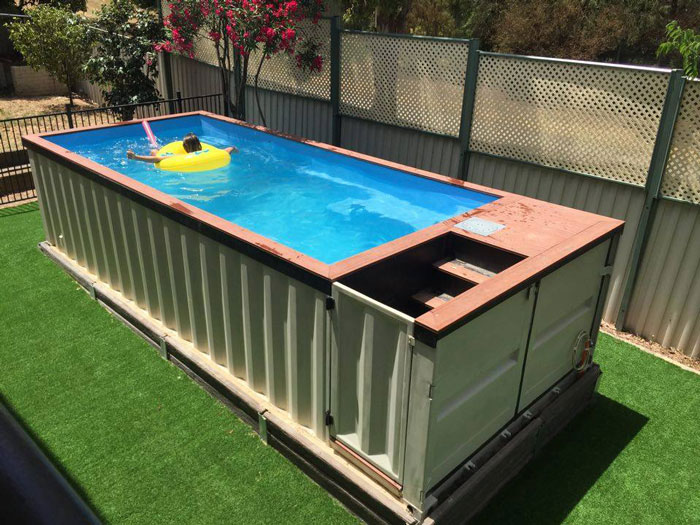
Do you need planning permission to install a pool?
Planning permission is required before you can build a new pool or have a container pool installed on your property. Whilst the terminology and specifics vary among states, it is universally recognised that any pool like structure with a filtration and pumping system will require approval.
Speak with your local council before you organise a container pool for your home.
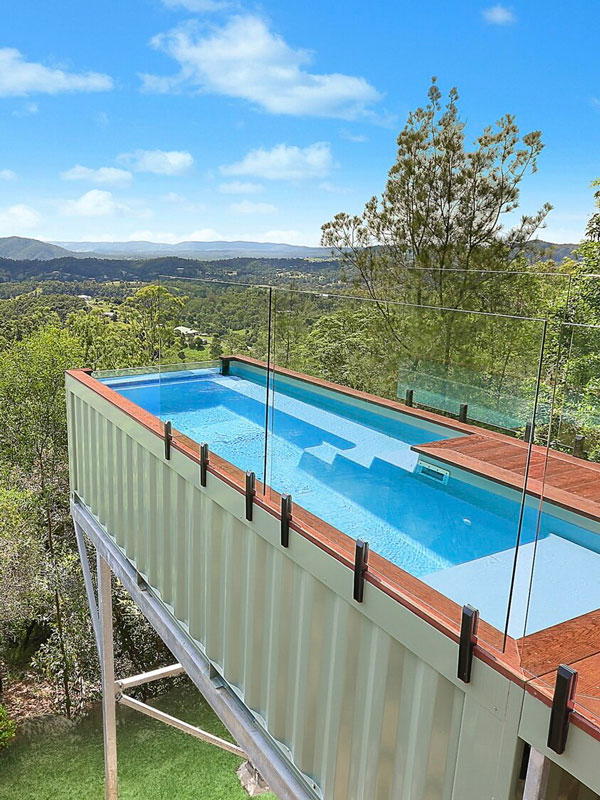
This container pool has views to die for over the ranges in the distance. Source: Shipping Container Pools
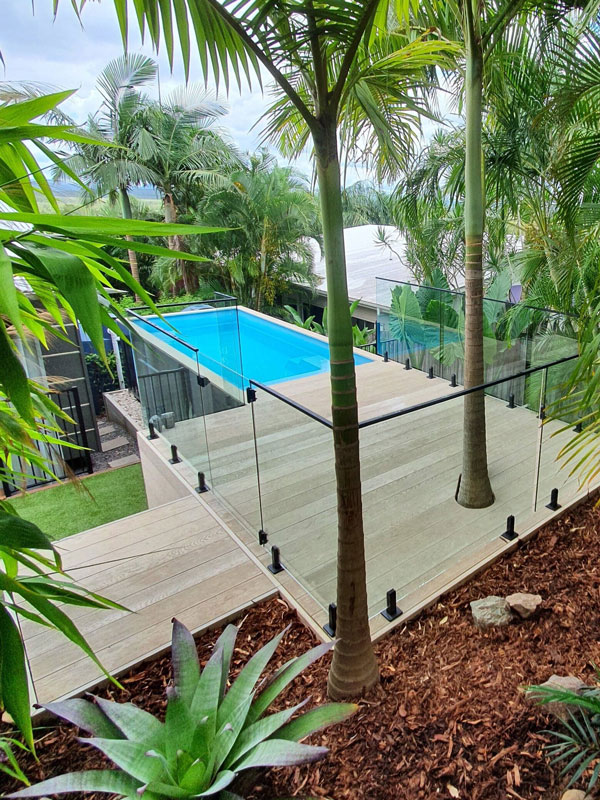
This container pool is hidden discreetly among a tropical garden. Source: Shipping Container Pools
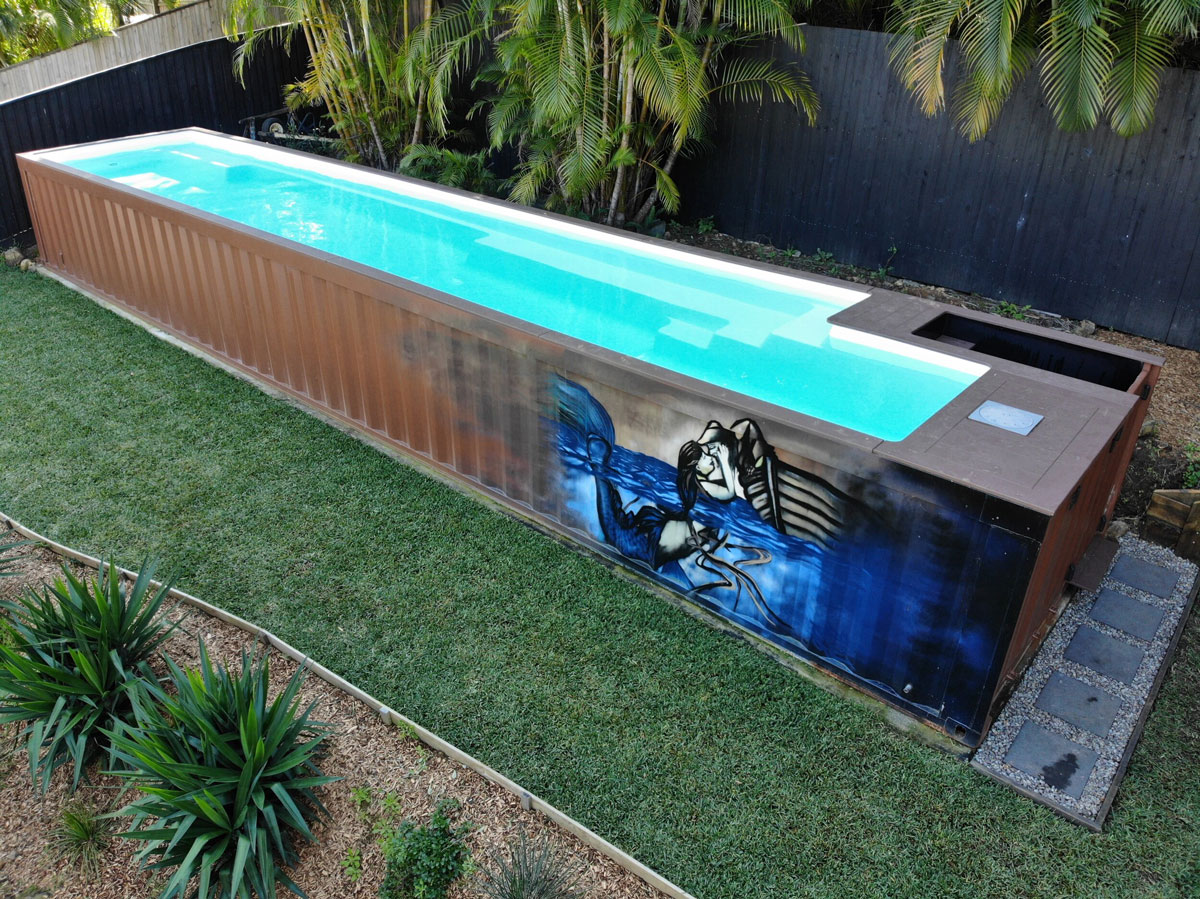
A container pool with a custom external display in a backyard. Source: Shipping Container Pools
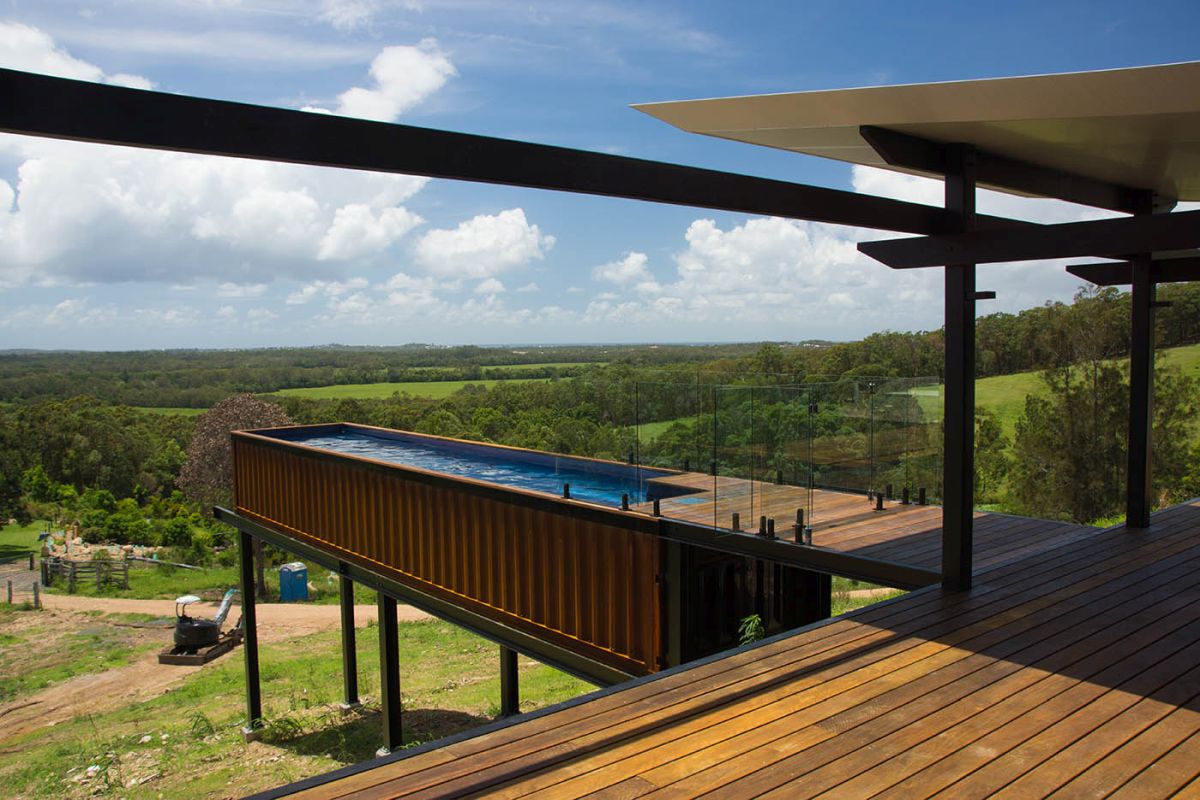
Another pool with a view, this time in Noosa. Source: Gibson Building
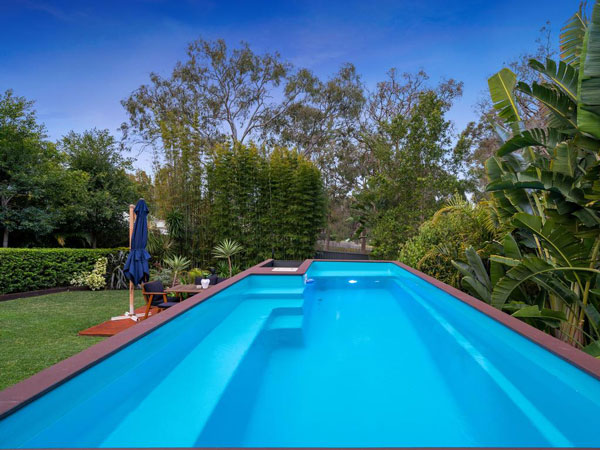
A neat container pool amongst landscaped gardens. Source: realestate.com.au

Take your pool to the next level with something like a window! Source: Modspools
Top 5 benefits of an integrated shipping container pool
What are the benefits of a container pool over a traditional backyard swimming pool?
1. Cheaper than a normal pool
In ground swimming pools cost between $30,000 and $100,000+.
In contrast, a small shipping container pool starts at ~$25,000.
Cost is critical when deciding on a pool and is one of the key benefits of a shipping container pool.
2. Perfect for a lap pool
A 40ft pool provides 12 metres of length for you to perfect your swimming in. Spend all day swimming laps in the cool comfort of a container pool.
3. They can be installed in one day
Shipping container pools are quick, easy and safe to install. Everything comes prefabricated and ready to go in one unit. Once it is lowered into position on footings, the pool just needs to be plugged in and filled before it is ready to go!
The pool can be built off site and delivered complete, unlike an inbuilt pool that requires major disruptions to your yard as earth is excavated and infrastructure is built.
4. The container pool can be moved around to different locations
If you ever move house, you can take your container pool with you. Just empty the water, put it on the back of a truck and relocate it to your new home. This will save you plenty of money and it guarantees that your new house comes with a pool!
5. You can style a container pool to suit your home layout
With preset rectangular shapes, you can easily place your container pool in a location on your block that doesn’t impact your house or your entertaining space.
Are there any disadvantages to container pools?
Whilst there are some clear benefits to a container pool, there are also some disadvantages.
1. Current Availability
Right now, containers can be difficult to source in Australia as a result of a global container shortage. Wait times have blown out and costs have skyrocketed, so you’re either likely to be waiting for a while to get one or you are going to pay more than you were expecting.
2. Restricted Layouts
If you’re after anything other than a rectangular layout, a container pool won’t work for you. Whilst concrete and fibreglass pools can be more expensive, they also give you more freedom, a greater potential area of water and features than a container pool.
3. Limited entry and exit points
The integrated design of a container pool usually only includes one entry and exit point. The width of the sides of the container are typically thin. This makes it challenging for children who like to jump in and out of pools regularly or parents who watch them get in and out of the pool anxiously.
Maintenance is also made more difficult. It is much harder to clean the pool to remove leaf litter and other debris, if you can only access the short end of it easily.
4. It could rust
For users who favour a salt water system, the container could rust over time. Whilst the best efforts are often taken to protect the container in rust proof paint, regular maintenance and repainting will be required to ensure the salt and water don’t penetrate the steel.
5. Ongoing costs
If your container pool is above the ground like most container pools are, the cost of heating and cooling your pool can add up quickly. Thermal properties of soil mean in ground pools are protected or insulated from dramatic fluctuations in temperature.
Choosing the right sized container pool for your home is made easier by the limited choices available - 20ft and 40ft.
Shipping container sizes are referenced by their length in feet.
For context, a 20ft container is just over 6 metres in length whilst a 40ft container is almost 13 metres in length.
In small yards, the 20ft container pool is the most popular option. On a larger block, both the 20ft and 40ft options are popular.
The nature of container pools, and their need for strong footings, means that homeowners can get creative and even place the pool on stilts, which lessens the impact of gradients or uneven land. It also makes a grand statement.

How long does it take to install a shipping container pool?
A shipping container pool can be installed in a single day. It is all built off site then delivered to site and secured by a qualified team.
This is much quicker than a concrete or vinyl liner swimming pool which can take many months to build.
Is a shipping container pool right for your layout?
Given the shape of 20ft and 40ft shipping containers, a container pool will likely be a good option for your layout if you are looking for a rectangular pool.
If you want something that has an unusual shape, sits in the ground or is built around some pre-existing infrastructure, then a concrete or even fibreglass pool is likely to be a better option for you.
Still keen to install a container pool?
SCF is a shipping container supplier, however we DO NOT modify shipping containers into swimming pools. You will need to engage a specialist container pool supplier if you wish to install one.
Before you commit to a container pool, be sure to check our other guides so that you are familiar with sizes, pricing and availability when discussing options with prospective container pool companies.
Subscribe & stay informed
Receive the latest in products, trends, news, events and tips.

